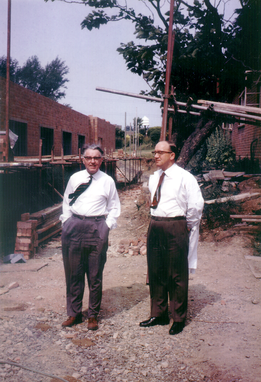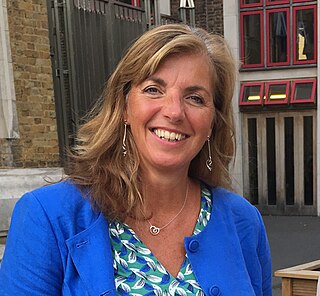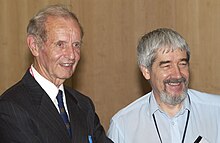The Science and Engineering Research Council (SERC) and its predecessor the Science Research Council (SRC) were the UK agencies in charge of publicly funded scientific and engineering research activities, including astronomy, biotechnology and biological sciences, space research and particle physics, between 1965 and 1994.
Sir Mark Edward Welland, is a British physicist who is a professor of nanotechnology at the University of Cambridge and head of the Nanoscience Centre. He has been a fellow of St John's College, Cambridge, since 1986 and started his career in nanotechnology at IBM Research, where he was part of the team that developed one of the first scanning tunnelling microscopes. He was served as the Master of St Catharine's College, Cambridge and took up office from 2016 to 2023.

Michael Ashburner was an English biologist and Professor in the Department of Genetics at University of Cambridge. He also served as joint-head and co-founder of the European Bioinformatics Institute (EBI) of the European Molecular Biology Laboratory (EMBL) and a Fellow of Churchill College, Cambridge.

Robert Samuel Langer Jr. FREng is an American biotechnologist, businessman, chemical engineer, chemist, and inventor. He is one of the nine Institute Professors at the Massachusetts Institute of Technology.
The Engineering and Physical Sciences Research Council (EPSRC) is a British Research Council that provides government funding for grants to undertake research and postgraduate degrees in engineering and the physical sciences, mainly to universities in the United Kingdom. EPSRC research areas include mathematics, physics, chemistry, artificial intelligence and computer science, but exclude particle physics, nuclear physics, space science and astronomy. Since 2018 it has been part of UK Research and Innovation, which is funded through the Department for Business, Energy and Industrial Strategy.

Functional near-infrared spectroscopy (fNIRS) is an optical brain monitoring technique which uses near-infrared spectroscopy for the purpose of functional neuroimaging. Using fNIRS, brain activity is measured by using near-infrared light to estimate cortical hemodynamic activity which occur in response to neural activity. Alongside EEG, fNIRS is one of the most common non-invasive neuroimaging techniques which can be used in portable contexts. The signal is often compared with the BOLD signal measured by fMRI and is capable of measuring changes both in oxy- and deoxyhemoglobin concentration, but can only measure from regions near the cortical surface. fNIRS may also be referred to as Optical Topography (OT) and is sometimes referred to simply as NIRS.

Louis Harold Gray FRS was an English physicist who worked mainly on the effects of radiation on biological systems. He was one of the earliest contributors of the field of radiobiology. Amongst many other achievements, he defined a unit of radiation dosage which was later named after him as an SI unit, the gray.

Michele Karen Dougherty is a British space scientist who is professor of space physics at Imperial College London. She is leading unmanned exploratory missions to Saturn and Jupiter and is Principal Investigator for J-MAG – a magnetometer for the European Space Agency's Jupiter Icy Moons Explorer, launched in April 2023.

David Tudor Jones is a Professor of Bioinformatics, and Head of Bioinformatics Group in the University College London. He is also the director in Bloomsbury Center for Bioinformatics, which is a joint Research Centre between UCL and Birkbeck, University of London and which also provides bioinformatics training and support services to biomedical researchers. In 2013, he is a member of editorial boards for PLoS ONE, BioData Mining, Advanced Bioinformatics, Chemical Biology & Drug Design, and Protein: Structure, Function and Bioinformatics.

Miles John Padgett is a Royal Society Research Professor of Optics in the School of Physics and Astronomy at the University of Glasgow. He has held the Kelvin Chair of Natural Philosophy since 2011 and served as Vice Principal for research at Glasgow from 2014 to 2020.

Susan C. Wray is professor of cellular and molecular physiology at the University of Liverpool. She also serves as the President of the International Union of Physiological Sciences (IUPS) and is president of the Federation of European Physiological Societies (FEPS). She was the founding editor-in-chief of Physiological Reports. and is the first editor-in-chief of Current Research in Physiology. She serves as director of the centre of better births in Liverpool Women's Hospital which was opened in 2013 with funding of £2.5 million with the objective of basic scientists working together with clinicians on problems during pregnancy. Along with Zarko Alfirevic, she leads the Harris wellbeing preterm birth centre. Wray is the director of the University of Liverpool Athena SWAN and team leader for the institute of translational medicine. Her primary research interests are in smooth muscle physiology, reproductive medicine and cell signalling.

Paul Anthony Midgley FRS is a Professor of Materials Science in the Department of Materials Science and Metallurgy at the University of Cambridge and a fellow of Peterhouse, Cambridge.
Raymond Ethan Goldstein FRS FInstP is the Alan Turing Professor of Complex Physical Systems in the Department of Applied Mathematics and Theoretical Physics (DAMTP) at the University of Cambridge and a Fellow of Churchill College, Cambridge.

Nikolay Zheludev is a British scientist specializing in nanophotonics, metamaterials, nanotechnology, electrodynamics, and nonlinear optics. Nikolay Zheludev is one of the founding members of the closely interlinked fields of metamaterials and nanophotonics that emerged at the dawn of the 21st century on the crossroads of optics and nanotechnology. Nikolay's work focus on developing new concepts in which nanoscale structuring of matter enhance and radically change its optical properties.

David John Wales is a professor of chemical physics in the Department of Chemistry at the University of Cambridge.
Alicia El Haj is a Professor and the Interdisciplinary Chair of Cell Engineering at the School of Chemical Engineering and the Healthcare Technologies Institute at the Institute of Translational Medicine, University of Birmingham. She is the President of the UK Bioengineering Society and Director of MICA Biosystems. She is a Fellow of the Royal Academy of Engineering. She was president of the European Council of the International Society for Tissue Engineering and Regenerative Medicine.
Elizabeth M. C. Hillman is a British-born academic who is Professor of Biomedical Engineering and Radiology at Columbia University. She was awarded the 2011 Adolph Lomb Medal from The Optical Society and the 2018 SPIE Biophotonics Technology Innovator Award.
Laura Maria Herz is a professor of physics at the University of Oxford. She works on femtosecond spectroscopy for the analysis of semiconductor materials.

Clare Elwell is a British academic who is a professor of medical physics and director of the Near Infrared Spectroscopy Group within the Biomedical Optics Research Laboratory at University College London. She has served as president of both the International Society on Oxygen Transport to Tissue and the Society for Functional Near Infrared Spectroscopy.
Marina Denise Anne Jirotka is professor of human-centered computing at the University of Oxford, director of the Responsible Technology Institute, governing body fellow at St Cross College, board member of the Society for Computers and Law and a research associate at the Oxford Internet Institute. She leads a team that works on responsible innovation, in a range of ICT fields including robotics, AI, machine learning, quantum computing, social media and the digital economy. She is known for her work with Alan Winfield on the 'Ethical Black Box'. A proposal that robots using AI should be fitted with a type of inflight recorder, similar to those used by aircraft, to track the decisions and actions of the AI when operating in an uncontrolled environment and to aid in post-accident investigations.












